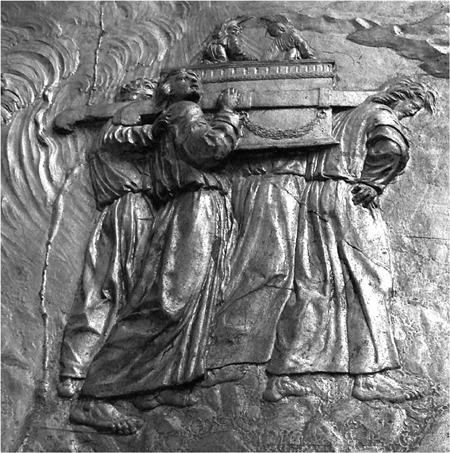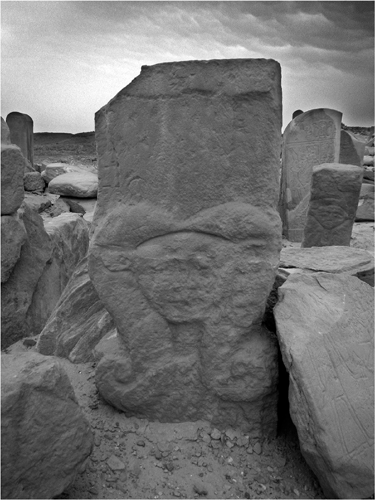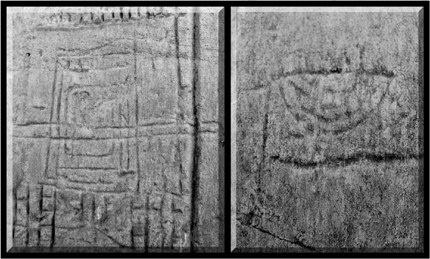
THE HAPU THREAD
“And they shall make an ark of acacia wood; two and half cubits shall be its length, a cubit and a half its width, and cubit and a half its height.
“And you shall overlay it with pure gold, inside and out you shall overlay it, and shall make on it a molding of gold all around.
“You shall cast four rings of gold for it, and put them in its four corners; two rings shall be on one side, and two rings on the other side.
“And you shall make poles of acacia wood, and overlay them with gold.
“You shall put the poles into the rings on the sides of the ark, that the ark may be carried by them.
“The poles shall be in the rings of the ark; they shall not be taken from it.
“And you shall put into the ark the Testimony which I will give you.
“You shall make a mercy seat of pure gold; two and a half cubits shall be its length and a cubit and a half its width.
“And you shall make two cherubim of gold; of hammered work you shall make them at the two ends of the mercy seat.
“Make one cherub at one end, and the other cherub at the other end; you shall make the cherubim at the two ends of it of one piece with the mercy seat.
“And the cherubim shall stretch out their wings above, covering the mercy seat with their wings, and they shall face one another; the faces of the cherubim shall be toward the mercy seat.
“You shall put the mercy seat on top of the ark, and in the ark you shall put the Testimony that I will give you.
“And there I will meet with you, and I will speak with you from above the mercy seat, from between the two cherubim which are on the ark of the Testimony, of all things which I will give you in commandment to the Children of Israel.”
I opened this chapter with the Old Testament quote from Exodus 25:10–22 regarding the Ark of the Covenant that God requested of Moses and the Children of Israel together with all the articles of the tabernacle. This also included the table for the showbread, the gold lamp stand, the altar of burnt offering, the altar of incense, the anointing oil and incense, the bronze laver, the court of the tabernacle, the garments of the priesthood, the ephod, the breastplate, and other priestly garments. I include such a detailed list because the items are important to the overall understanding of this chapter.
When Moses left Egypt with the freed Hebrew slaves, they plundered the Egyptians. This bounty was mentioned again when the Egyptian army was crossing the Red Sea to recapture the Hebrew slaves and their bounty. However, the merciful God had other plans and crushed them beneath the heavy waters of the sea, drowning them and sending their bodies to a watery grave. Were they Hebrews when they left Egypt? I suggest that they were not Hebrew by any stretch of the imagination, but were most definitely Egyptian. How a man that was born and brought up in a country in which his ancestors were also born and raised 400 years prior can hail himself from a different nation is absurd. By all means assign a heritage or a hereditary culture, but we arrive at the same question I asked earlier, and that is: Where is the evidence to support the biblical scripture and the identity of the Hebrews? I continue to search but return empty handed.

A depiction of the Ark of the Covenant in bas-relief.
However, if we take a different route and tackle this from a different perspective, one that respects the heritage and culture but also recognizes the culture and homeland from which they have been raised, I would propose that the people Moses freed from captivity were indeed Egyptians. We can indeed find evidence in Exodus for this as we continue to read through the various verses.
The first verse that I would like to bring to your attention is “The Song of Miriam,” in which the sister of Moses and Aaron takes a timbrel in her hand and begins to play a tune together with the women of Israel and associated dances begin to celebrate their miraculous escape out of the clutches of the pharaoh, and his chariots by the hand of God.
Sing to the Lord,
For He has triumphed gloriously!
The horse and its rider
He has thrown into the sea!
I can accept the celebration and its associated festivities at surviving such an ordeal, but I draw a comparison with that of the Hathoric priestesses and their musical dances and exotic movements. The timbrel is also the musical instrument that the God Bes is playing while dancing in the pictorial relief, represented on the side of the gilded chairs that adorned the tomb of the Princess Sitamun’s grandparents. As I have suggested already, I propose that the character of Miriam is based upon Princess Sitamun and her associations with the Hathoric cult, along with Hapu’s mother. It was extremely popular during the 18th Dynasty for the women of the household in the upper classes to be connected with the cult of Hathor. It would also be sensible to suggest that the Egyptians that had fled Egypt with Moses would have had exposure to the Hathoric cult in one way or another regardless of their class location. So, covering all sides of the arguments, it is obvious that the Egyptian women that came out to celebrate their victory performed a semi-ritualistic dance based upon Hathoric themes.
The Ark of the Covenant is probably one of the most misunderstood items that the Hebrews created during their time in the wilderness. Adorning the walls of the Egyptian temples, the Barque Shrine stands out from most of them. It is a rectangular box that has certain characteristic adornments attached to it as decoration, having poles that are connected to the four corners to facilitate carrying upon the shoulders of the priests. It usually rests upon another rectangular box that elevates it off the ground, with tables and stands by its sides, which hold various libational jugs and other liquid holding vessels. Offering plates, lamps, and fans usually stand by its side. All of these are contained within a tabernacle, held by ornate poles to the corners with a decorative freeze adorning the top trim.

In the Sinai wilderness, high atop the remote mountain of Serabit el Khadim, stands the Sanctuary Temple of Hathor. This is one of her many depictions at the ancient site.
Do any of the items have any resemblance to the passage that I wrote at the beginning of this chapter or the remaining articles of the tabernacle that were requested of Moses by God?
Egyptian Barque Shrine from the walls of Luxor Temple depicting the Opet Festival. Does it look familiar?
It is clear that the Ark of the Covenant is indeed an Egyptian Barque Shrine that has its roots within the confines of the sacred temples of Egypt. Returning to the question of whether the Hebrew slaves were indeed Hebrew or Egyptian, the Barque Shrine is the best example of this argument. The craftsmen were instructed to build the Ark utilizing their own knowledge that they had learned while in Egypt, which led to the Barque shrine complete with the two protective goddesses that usually adorn the opposing sides of any sarcophagus: Isis and Nephthys, the sisters of Osiris. Now the important question has to be whether Moses actually ever commissioned the Ark and whether it was an addition by the Judaic scholars in Alexandria? Another question to raise is: What language were the tablets written in that held the Ten Commandments? Was it Hieratic, Hieroglyphic, or some other kind of cursive text? The Egyptian Barque Shrine was used during most celebrations; it carried within it the idol of the respective temple it originated from. These representations of the living gods could then visit one another by being carried on the shoulders of the incumbent priests. One of the best and most beautiful depictions of this kind of festivity is the Opet festival that took place between Karnak and Luxor. The Theban triad was carried aloft along the spectacular Sphinx-lined avenue on the shoulders of the white-robed priests, freshly shaven and having their leopard skins draped over their chests, wearing their turned-up sandals. The Barque Shrine would have the illusion of gliding through the air. This was preceded by an array of dignitaries and other high officials all dressed and looking rather pompous as they strode ahead of the divine Barque.

Two bits of ancient graffiti depicting Egyptian Barque Shrines from the walls of southern Karnak temple. Could either of these possibly be the Ark of the Covenant?
The incised relief upon the walls of the enclosed colonnade at Luxor Temple depicts the procession in wonderful detail, complete with the facial expressions of the priests as they proudly hold aloft their beloved God on their humble shoulders. But it is the Barque Shrine that is important here; they contain within them the living personification of the God in statuette form, the words of God, the forms of God, the dress of God. The ark is merely another representation of the Egyptian Barque Shrine and not a new invention of the Judaic religion. It held the words of God written on Egyptian stelae or tablets, probably made from sandstone.
Similar to the famous crowns of the Egyptian pharaohs, not one Barque Shrine has yet to be discovered; given the number of temples and shrines it is hard to comprehend that not one has survived the tests of time. Yet when we begin to understand the significance of them, one can then begin to appreciate why none have survived. However, many scholars and independent researchers have claimed to have discovered one or another hidden in sacred unapproachable sanctuaries, in Ethiopia, Sudan, Somalia, or even in Glastonbury, England!
Did the freed Hebrew slaves carry before them the power of God held within a box of acacia wood gilded in gold? Again this falls directly within the faith camp. I have discussed the Barque Shrine as a means of transporting the living Gods incarnate within statues and not some mystical energy source that emitted some kind of radiation that consumed those who touched it. The Old Testament can be seen by many as a collection of horrific stories that tell of mass genocide, murder, rape, adultery, and other horrifying acts of human insanity. For me, it is purely a controlling aspect of the indoctrination that goes hand-in-hand with the religion. But for sure, we will never uncover the real truth of what took place in the wilderness, or if it took place at all as we have been led to believe.
I can easily imagine Hapu at Serabit el Khadim with his hand-held steles adorned with the hieratic scripts of Spell 125, having climbed down the mountain and approached the Crown Prince, and in gesture of benevolence he placed the steles in the living Horus’s hands, empowering him in front of the watchful crowd. There is a certain serenity in writing about Hapu; he seems to bring out the good in me. I see the predicaments and problems in a different way. I do not see the murder and destruction that I have had to read through and pour over within the Old Testament. With Hapu I have had to imagine the pure anguish by those who experienced the destruction of Thebes. The death and chaos that ensued in the aftermath, the correlation to the plagues, the rise and subsequent destruction of the old guard as Atenists took to the streets desecrating and eradicating the name and words of Amun-Ra. It has been a struggle at times to remain neutral and maintain a level ground on which to base my theories. I encourage you to question and research. Look for the truths hidden behind metaphors and dogma. For sure we will never uncover all the truths, but we can start. As I have said before, it was never my intention to replace Moses as a historical and religious icon; I merely wanted to show that there are other plausible scenarios that should be explored and investigated. It is certain that Hapu knew he had served and he had observed, but more importantly he did not dictate.